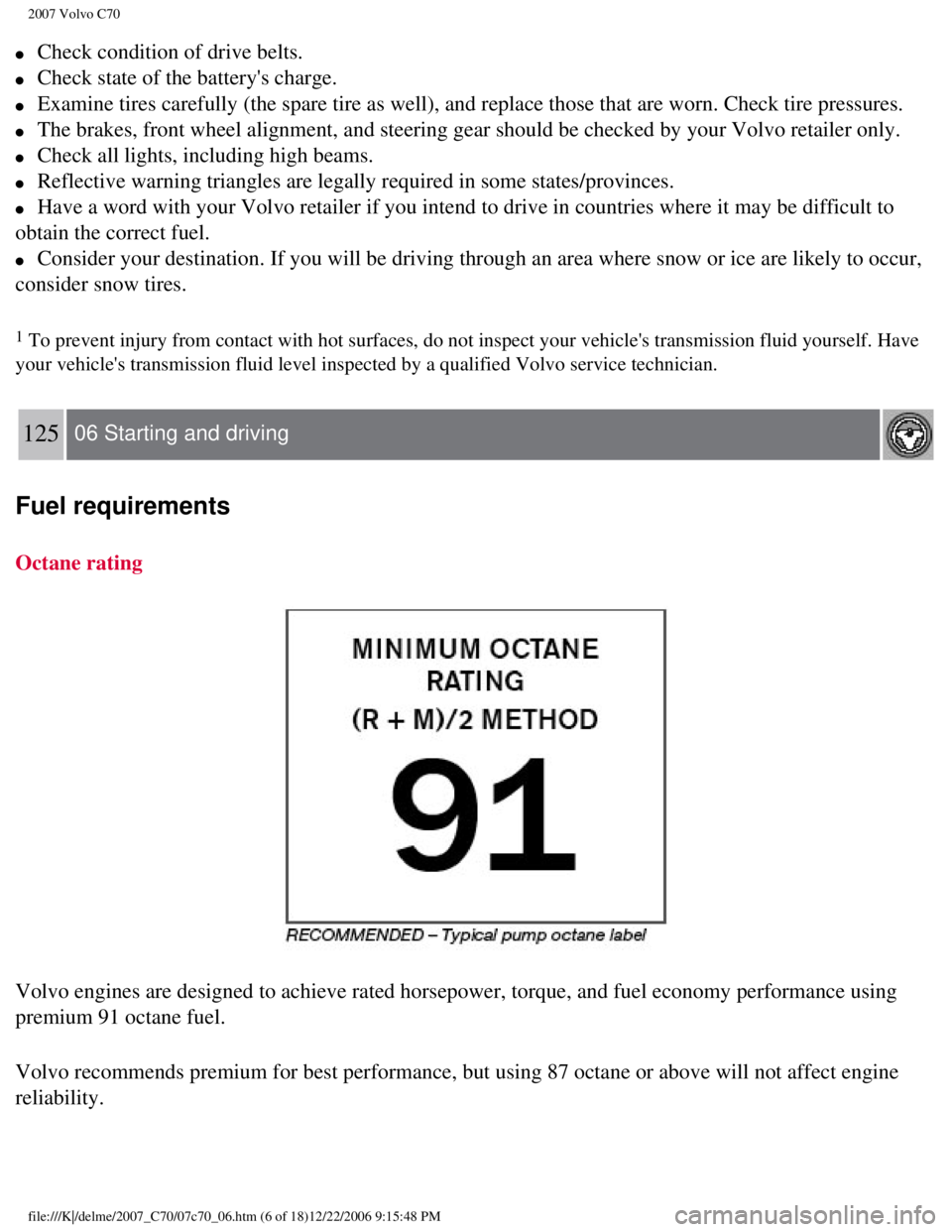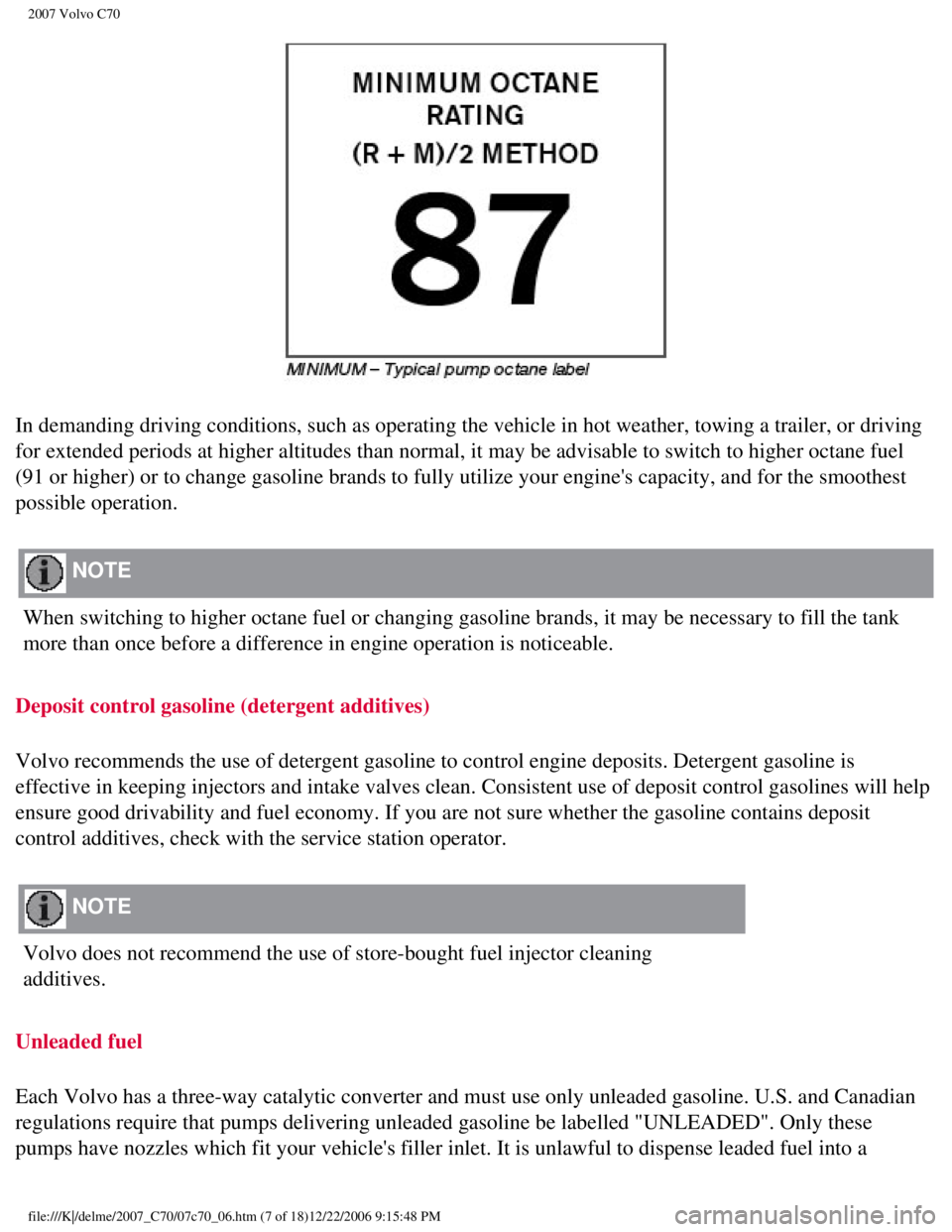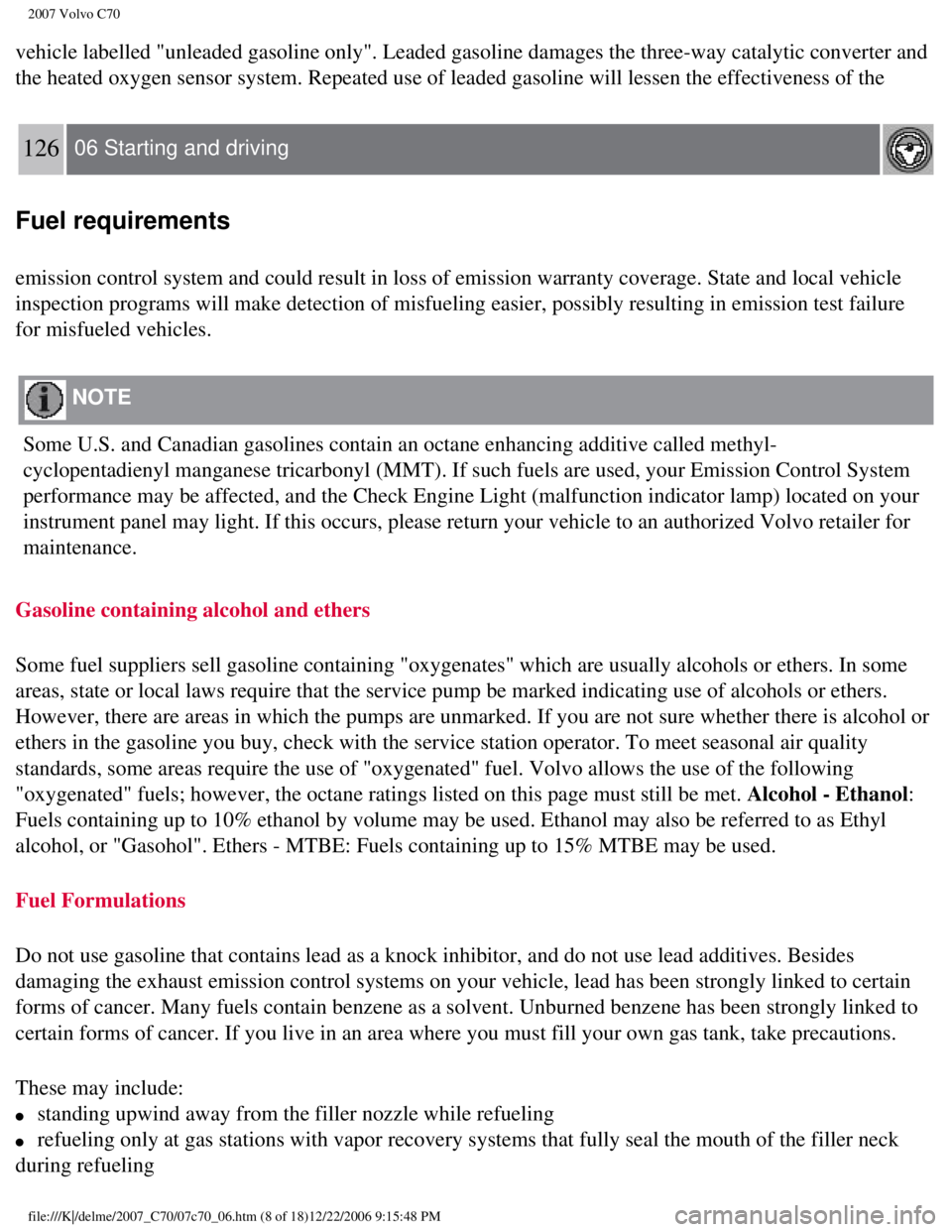check engine VOLVO C70 CONVERTIBLE 2007 Owner´s Manual
[x] Cancel search | Manufacturer: VOLVO, Model Year: 2007, Model line: C70 CONVERTIBLE, Model: VOLVO C70 CONVERTIBLE 2007Pages: 276, PDF Size: 9.81 MB
Page 147 of 276

2007 Volvo C70
l Check condition of drive belts.
l Check state of the battery's charge.
l Examine tires carefully (the spare tire as well), and replace those th\
at are worn. Check tire pressures.
l The brakes, front wheel alignment, and steering gear should be checked b\
y your Volvo retailer only.
l Check all lights, including high beams.
l Reflective warning triangles are legally required in some states/provinc\
es.
l Have a word with your Volvo retailer if you intend to drive in countries\
where it may be difficult to
obtain the correct fuel.
l Consider your destination. If you will be driving through an area where \
snow or ice are likely to occur,
consider snow tires.
1 To prevent injury from contact with hot surfaces, do not inspect your v\
ehicle's transmission fluid yourself. Have
your vehicle's transmission fluid level inspected by a qualified Volvo s\
ervice technician.
125 06 Starting and driving
Fuel requirements
Octane rating
Volvo engines are designed to achieve rated horsepower, torque, and fuel\
economy performance using
premium 91 octane fuel.
Volvo recommends premium for best performance, but using 87 octane or ab\
ove will not affect engine
reliability.
file:///K|/delme/2007_C70/07c70_06.htm (6 of 18)12/22/2006 9:15:48 PM
Page 148 of 276

2007 Volvo C70
In demanding driving conditions, such as operating the vehicle in hot we\
ather, towing a trailer, or driving
for extended periods at higher altitudes than normal, it may be advisabl\
e to switch to higher octane fuel
(91 or higher) or to change gasoline brands to fully utilize your engi\
ne's capacity, and for the smoothest
possible operation.
NOTE
When switching to higher octane fuel or changing gasoline brands, it may\
be necessary to fill the tank
more than once before a difference in engine operation is noticeable.
Deposit control gasoline (detergent additives)
Volvo recommends the use of detergent gasoline to control engine deposit\
s. Detergent gasoline is
effective in keeping injectors and intake valves clean. Consistent use o\
f deposit control gasolines will help
ensure good drivability and fuel economy. If you are not sure whether th\
e gasoline contains deposit
control additives, check with the service station operator.
NOTE
Volvo does not recommend the use of store-bought fuel injector cleaning \
additives.
Unleaded fuel
Each Volvo has a three-way catalytic converter and must use only unleade\
d gasoline. U.S. and Canadian
regulations require that pumps delivering unleaded gasoline be labelled \
"UNLEADED". Only these
pumps have nozzles which fit your vehicle's filler inlet. It is unlawful\
to dispense leaded fuel into a
file:///K|/delme/2007_C70/07c70_06.htm (7 of 18)12/22/2006 9:15:48 PM
Page 149 of 276

2007 Volvo C70
vehicle labelled "unleaded gasoline only". Leaded gasoline damages the t\
hree-way catalytic converter and
the heated oxygen sensor system. Repeated use of leaded gasoline will le\
ssen the effectiveness of the
126 06 Starting and driving
Fuel requirements
emission control system and could result in loss of emission warranty co\
verage. State and local vehicle
inspection programs will make detection of misfueling easier, possibly r\
esulting in emission test failure
for misfueled vehicles.
NOTE
Some U.S. and Canadian gasolines contain an octane enhancing additive ca\
lled methyl-
cyclopentadienyl manganese tricarbonyl (MMT). If such fuels are used, \
your Emission Control System
performance may be affected, and the Check Engine Light (malfunction in\
dicator lamp) located on your
instrument panel may light. If this occurs, please return your vehicle t\
o an authorized Volvo retailer for
maintenance.
Gasoline containing alcohol and ethers
Some fuel suppliers sell gasoline containing "oxygenates" which are usua\
lly alcohols or ethers. In some
areas, state or local laws require that the service pump be marked indic\
ating use of alcohols or ethers.
However, there are areas in which the pumps are unmarked. If you are not\
sure whether there is alcohol or
ethers in the gasoline you buy, check with the service station operator.\
To meet seasonal air quality
standards, some areas require the use of "oxygenated" fuel. Volvo allows\
the use of the following
"oxygenated" fuels; however, the octane ratings listed on this page must\
still be met. Alcohol - Ethanol:
Fuels containing up to 10% ethanol by volume may be used. Ethanol may al\
so be referred to as Ethyl
alcohol, or "Gasohol". Ethers - MTBE: Fuels containing up to 15% MTBE ma\
y be used.
Fuel Formulations
Do not use gasoline that contains lead as a knock inhibitor, and do not \
use lead additives. Besides
damaging the exhaust emission control systems on your vehicle, lead has \
been strongly linked to certain
forms of cancer. Many fuels contain benzene as a solvent. Unburned benze\
ne has been strongly linked to
certain forms of cancer. If you live in an area where you must fill your\
own gas tank, take precautions.
These may include:
l standing upwind away from the filler nozzle while refueling
l refueling only at gas stations with vapor recovery systems that fully se\
al the mouth of the filler neck
during refueling
file:///K|/delme/2007_C70/07c70_06.htm (8 of 18)12/22/2006 9:15:48 PM
Page 151 of 276

2007 Volvo C70
pump's ability to supply the engine with an adequate supply of fuel.
Therefore, it is advisable to refuel as soon as possible when the needle\
nears the red zone, or when the
fuel warning light comes on.
1Models with All Wheel Drive have a tank volume of 15 US gallons (57 lit\
ers). Models with engine code 39 have
a fuel tank capacity of 14 US gallons (53 liters). This code is the 6t\
h and 7th digits from the left in your vehicle's
VIN number. See
page 235 for the location of the VIN plate.
CAUTION
l Do not refuel with the engine running1. Turn the ignition off or to position I. If the ignition is on, an
incorrect reading could occur in the fuel gauge
l After refueling, close the fuel filler cap by turning it clockwise until\
it clicks into place.
l Avoid overfilling the fuel tank. Do not press the handle on the filler n\
ozzle more than one extra time.
Too much fuel in the tank in hot weather conditions can cause the fuel t\
o overflow. Overfilling could
also cause damage to the emission control systems.
l Avoid spilling gasoline during refueling. In addition to causing damage \
to the environment, gasolines
containing alcohol can cause damage to painted surfaces, which may not b\
e covered under the New
Vehicle Limited Warranty.
l Do not use gasolines containing methanol (methyl alcohol, wood alcohol)\
. This practice can result in
vehicle performance deterioration and can damage critical parts in the f\
uel system. Such damage may
not be covered under the New Vehicle Limited Warranty.
1If the fuel filler cap is not closed tightly or if the engine is running\
when the vehicle is refueled, the Check Engine
Light (malfunction indicator lamp) may indicate a fault. However, your\
vehicle's performance will not be affected.
Use only Volvo original or approved fuel filler caps.
128 06 Starting and driving
Ignition switch, Steering wheel lock
Ignition switch and steering wheel lock
0 - Locked position
Remove the key to lock the steering wheel. Never turn the key to positi\
on 0 while driving
file:///K|/delme/2007_C70/07c70_06.htm (10 of 18)12/22/2006 9:15:48 PM\
Page 153 of 276

2007 Volvo C70
unlock.
If so, the key will turn in the ignition switch but the car will not sta\
rt.
At the same time, a message "Steering locked turn wheel" will appear in \
the information display.
If this happens:
1. Remove the key from the ignition.
2. Turn the steering wheel slightly and hold it to release pressure on t\
he lock mechanism.
3. Reinsert the key and start the vehicle. The steering should immediate\
ly unlock. If not, try again.
NOTE
In order to help reduce vehicle theft, make sure the steering wheel lock\
is engaged before leaving the
vehicle.
WARNING
Never switch off the ignition (turn the ignition key to position 0) or\
remove the key from the ignition
switch while the vehicle is in motion. This could cause the steering whe\
el to lock, which would make
the vehicle impossible to steer.
129 06 Starting and driving
Starting the vehicle
To start the engine
1. Fasten the seat belt.
WARNING
Before starting, check that the seat, steering wheel and mirrors are adj\
usted properly. Make sure the
brake pedal can be depressed completely. Adjust the seat if necessary.
2. Apply the parking brake if not already set. The gear selector should \
be locked in the Park (P) position
file:///K|/delme/2007_C70/07c70_06.htm (12 of 18)12/22/2006 9:15:48 PM\
Page 156 of 276

2007 Volvo C70
Remove your foot from the clutch pedal while driving. The shift pattern \
should be followed.
Overdrive (5th and 6th gears) should be used as often as possible to h\
elp improve fuel economy.
1 Clutch interlock
The clutch must be fully depressed before you can start your car. If the\
clutch is not depressed, it will not be
possible to start the engine.
Engaging reverse gear, 6-speed transmission
Reverse gear should only be engaged from a complete stop.
NOTE
Reverse gear is electronically blocked and cannot be selected if the veh\
icle is moving at a speed of
approximately 13 mph (20 km/h).
CAUTION
Never shift into reverse while moving
forward.
WARNING
An extra mat on the driver's floor can cause the accelerator, brake, and\
/or clutch pedal to catch. Check
that the movement of these pedals is not impeded. Not more than one prot\
ective floor covering may be
used at one time.
file:///K|/delme/2007_C70/07c70_06.htm (15 of 18)12/22/2006 9:15:48 PM\
Page 183 of 276

2007 Volvo C70
Temporarily repairing a flat tire
Before using the tire sealing system, observe the following:
WARNING
l Never leave the tire sealing system unattended when it is operating.
l Keep the tire sealing system kit away from children.
l The vehicle's engine should be running when the tire sealing system is u\
sed to avoid battery drain.
Therefore, be sure the vehicle is parked in a well ventilated place befo\
re using the system.
l Be sure the vehicle is parked safely off the road and away from moving t\
raffic.
l Apply the parking brake.
l Do not remove any foreign objects (nails, etc.) from the tire.
172 07 Wheels and tires
Tire sealing system
Temporarily repairing a flat tire is done in two stages
l In the first stage, the hole is sealed by pumping sealing compound into \
the tire. The car is then driven a
short distance to distribute the sealing compound in the tire.
l In the second stage, the tire's inflation pressure is checked and adjust\
ed if necessary.
Stage 1 - Sealing the hole
Peel off the speed limit sticker (1) and affix it to the steering whee\
l hub where it will be clearly visible to
the driver.
file:///K|/delme/2007_C70/07c70_07.htm (24 of 30)12/22/2006 9:15:51 PM\
Page 185 of 276

2007 Volvo C70
If the pressure remains below 22 psi (1.8 bar) after approximately sev\
en minutes, turn off the
compressor. In this case, the hole is too large to be sealed and the veh\
icle should not be driven.
10. Unscrew the hose from the tire's inflation valve and reinstall the v\
alve cap.
11. Fold down the orange section of the tire sealing system to its origi\
nal (horizontal) position and press
the safety catch into place.
12. Safely stow the tire sealing system kit in a convenient place as it \
will soon be used again to check the
tire's inflation pressure.
13. Immediately drive the vehicle for approximately 2 miles (3 km) to \
distribute the sealing compound in
the tire.
173 07 Wheels and tires
Tire sealing system
Stage 2 - Checking inflation pressure
1. Park the car in a safe place.
2. Ensure that the orange switch (2) is in position 0 (the 0 side of \
the switch should be pressed down).
3. Remove the valve cap from the tire's inflation valve and screw the ho\
se connector onto the valve as
tightly as possible by hand.
WARNING
If heavy vibrations, unsteady steering behavior, or noises should occur \
while driving, reduce speed and
park the car in a safe place. Recheck the tire for bumps, cracks, or oth\
er visible damage, and recheck its
inflation pressure. If the pressure is below 16 psi (1.3 bar), do not \
continue driving. Have the vehicle
towed to a workshop or Volvo retailer.
4. Connect the electrical wire to the nearest 12-volt socket in the vehi\
cle.
5. Start the vehicle's engine.
6. Check the tire's inflation pressure on the gauge (9).
file:///K|/delme/2007_C70/07c70_07.htm (26 of 30)12/22/2006 9:15:51 PM\
Page 199 of 276

2007 Volvo C70
Periodic maintenance will help keep your vehicle running well. Your Warr\
anty and Service Records
Information booklet provides a comprehensive periodic maintenance schedu\
le up to 150,000 miles
(240,000 km) of vehicle maintenance. The schedule includes components \
that affect vehicle emissions.
This page describes some of the emission-related components.
Vehicle Event Data (Black Box)
Your vehicle's driving and safety systems employ computers that monitor,\
and share with each other,
information about your vehicle's operation. One or more of these compute\
rs may store what they monitor,
either during normal vehicle operation or in a crash or near-crash event\
. Stored information may be read
and used by:
l Volvo Car Corporation
l service and repair facilities
l law enforcement or government agencies
l others who may assert a legal right to know, or who obtain your consent \
to know such information.
187 09 Maintenance and servicing
Maintaining your vehicle
Owner maintenance
Periodic maintenance requirements and intervals are described in your ve\
hicle's Warranty and Service
Records Information booklet.
The following points can be carried out between the normally scheduled m\
aintenance services.
Each time the car is refueled:
l Check the engine oil level
l Clean the windshield, windshield wipers, headlights, and taillights
Monthly:
l Check cold tire pressure in all tires. Inspect the tires for wear.
l Check that engine coolant and other fluid levels are between the indicat\
ed "min" and "max" markings.
l Clean interior glass surfaces with a glass cleaner and soft paper towels\
.
l Wipe driver information displays with a soft cloth.
l Visually inspect battery terminals for corrosion. Corrosion may indicate\
a loose terminal connector, or
a battery near the end of its useful service life. Consult your Volvo re\
tailer for additional information.
As needed:
l Wash the car, including the undercarriage, to reduce wear that can be ca\
used by a buildup of dirt, and
file:///K|/delme/2007_C70/07c70_09.htm (3 of 36)12/22/2006 9:15:54 PM
Page 200 of 276

2007 Volvo C70
corrosion that can be caused by salt residues.
l Clean leaves and twigs from air intake vents at the base of the windshie\
ld, and from other places where
they may collect.
NOTE
Complete service information for qualified technicians is available onli\
ne for purchase or subscription at
www.volvotechinfo.com.
188 09 Maintenance and servicing
Maintaining your vehicle
Emission inspection readiness
What is an Onboard Diagnostic System (OBD II)?
OBD II is part of your vehicle's computerized engine management system. \
It stores diagnostic
information about your vehicle's emission controls. It can light the Che\
ck Engine light (MIL) if it detects
an emission control "fault." A "fault" is a component or system that is \
not performing within an expected
range. A fault may be permanent or temporary. OBD II will store a messag\
e about any fault.
How Do States Use OBD II for Emission Inspections?
Many states connect a computer directly to a vehicle's OBD II system. Th\
e inspector can then read
"faults." In some states, this type of inspection has replaced the tailp\
ipe emission test.
How Can My Vehicle Fail OBD II Emission Inspection?
Your vehicle can fail OBD II emission inspection for any of the followin\
g reasons.
l If your Check Engine (MIL) light is lit, your vehicle may fail inspect\
ion.
l If your vehicle's Check Engine light was lit, but went out without any a\
ction on your part, OBD II will
still have a recorded fault. Your vehicle may pass or fail, depending on\
the inspection practices in your
area.
l If you had recent service that required disconnecting the battery, OBD I\
I diagnostic information may be
incomplete and "not ready" for inspection. A vehicle that is not ready m\
ay fail inspection.
How Can I Prepare for My Next OBD II Emission Inspection?
l If your Check Engine (MIL) light is lit - or was lit but went out with\
out service, have your vehicle
diagnosed and, if necessary, serviced by a qualified Volvo technician.
l If you recently had service for a lit Check Engine light, or if you had \
service that required
disconnecting the battery, a period of driving is necessary to bring the\
OBD II system to "ready" for
inspection. A half-hour trip of mixed stop-and-go/highway driving is typ\
ically needed to allow OBD II to
reach readiness. Your Volvo retailer can provide you with more informati\
on on planning a trip.
file:///K|/delme/2007_C70/07c70_09.htm (4 of 36)12/22/2006 9:15:54 PM